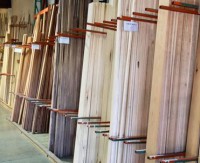 My very first “fine woodworking” project was the jewelry box for Tyla. It took me forever to get started because I had no idea how you get the right wood. Up until that point, all of my projects had been made out of pine from Home Depot. All the plans I used were built around those common dimensions (1×4, 2×6, etc.) But the plans for the jewelry box called for some wood that was 1/4″ thick and some other pieces were 1/2″ or 3/4″. What was the best way to deal with that? I had a hard time figuring it out so I thought I’d write a “wood buying 101″ guide. I’m FAR from an expert but I do feel more comfortable buying wood now so I can share what I know.
My very first “fine woodworking” project was the jewelry box for Tyla. It took me forever to get started because I had no idea how you get the right wood. Up until that point, all of my projects had been made out of pine from Home Depot. All the plans I used were built around those common dimensions (1×4, 2×6, etc.) But the plans for the jewelry box called for some wood that was 1/4″ thick and some other pieces were 1/2″ or 3/4″. What was the best way to deal with that? I had a hard time figuring it out so I thought I’d write a “wood buying 101″ guide. I’m FAR from an expert but I do feel more comfortable buying wood now so I can share what I know.
When you buy hardwoods, you’re not buying the specific size pieces you’re going to use. You’re buying pieces are wider, thicker and longer than anything you’re going to need to cut. Then you have work to do when you get home to mill the wood to the right dimensions.
If you want to do this at home, you’re going to need at least one tool: a thickness planer. In my case, I knew a guy with one and I’d borrows his for projects. (Thanks Tim!) A thickness planer lets you reduce the thickness of your board. You have to do it in small passes but you can turn an entire board into sawdust if you so desire. It’s pretty wasteful to take a 3/4″ board and plane it down to 1/4” but it does work and that’s how I built the jewelry box.
The band saw was a big step up for me. Now I had the ability to saw a wood into halves (or even thirds) and then plane off much less wood to end up with two or three pices that were all thin.
And the third tool that you might consider is a jointer. A jointer helps you make one side completely flat and then make an adjacent side flat and 90 degeres to your first face. This is very important when dealing with very rough lumber.
Once you know what what tools you have to work with, then you are ready for a hardwood dealer. Home Depot isn’t a bad place to start. They sell very clean boards that are already jointed (perfectly 90 degree corners) so all you’d have to do is plane them down to the right thickness. You don’t get a wide variety, but the prices aren’t outrageously high.
To really blow your mind, check out a real hardwood dealer like Crosscut Hardwoods in Seattle. They have dozens of different hardwood spieces in a variety of sizes. You can also buy them in various stages of the milling process.
- S4S will be the easiest to work with. That means “surfaced four sides.” It’s planed and jointed all the way around.
- S3S is planed and jointed on three sides with line “wild” side.
- S2S has been run thorugh a planer leaving you with two flat faces.
There are others but those are the basics. Then you need to decide on the thickness. You’ll see this listed as 4/4, 5/4, 6/4 or something like that. It’s pronounced “four quarter”, “five quarter”, etc and it’s fractions of an inch. So 4/4 is one inch thick. Note that it might not be EXACTLY one inch, especially if you’re buying wood that has been planed for you already.
The final thing you need to know is “board feet.” Prices will be listed per board foot. To calculate how many board feet a board is, multiple the thickness, width and lenght (all in inches) and divide by 144. A 1″ thick board that is 12″ square will be exactly 1 board foot. But don’t worry, you rarely have to do that math in the store. Each board usually has a number written on it in chalk and that is the number of board feet for that specific piece of wood. Multiple that number by the unit price and you’re all set.
You might not have to buy the entire board either. At Crosscut, it’s not uncommon to see 12 or 16′ boards. They will let you buy small pieces of the wood as long as you leave at least 8′ for them to sell. They will also crosscut the boards for you for transport, but all that cutting happens after you have paid your money.
Hopefully this demystifies hardwoods a bit. Happy woodworking!
